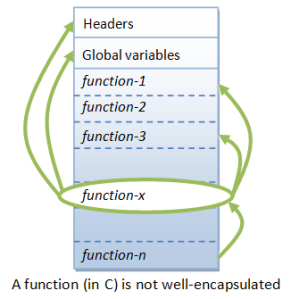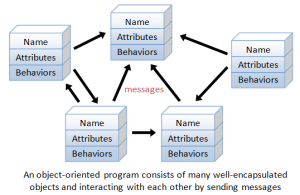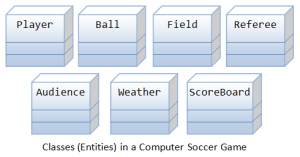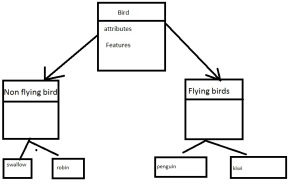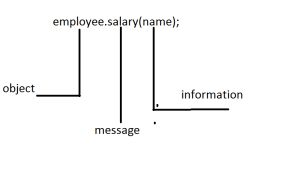1. Why OOP?
Suppose that you want to assemble your own PC, you go to a
hardware store and pick up a motherboard, a processor, some RAMs,
a hard disk, a casing, a power supply, and put them together.
You turn on the power, and the PC runs. You need not worry
whether the motherboard is a 4-layer or 6-layer board,
whether the hard disk has 4 or 6 plates; 3 inches or 5 inches in diameter,
whether the RAM is made in Japan or Korea, and so on.
You simply put the hardware components together
and expect the machine to run. Of course, you have to make sure that
you have the correct interfaces, i.e., you pick an IDE hard disk
rather than a SCSI hard disk, if your motherboard supports only IDE;
you have to select RAMs with the correct speed rating, and so on.
Nevertheless, it is not difficult to set up a machine from hardware components.
Similarly, a car is assembled from parts and components,
such as chassis, doors, engine, wheels, break, transmission, etc.
The components are reusable, e.g., a wheel can be
used in many cars (of the same specifications).
Hardware, such as computers and cars, are assembled from parts,
which are reusable components.
How about software? Can you “assemble” a software application
by picking a routine here, a routine there, and expect the program to run?
The answer is obviously no! Unlike hardware,
it is very difficult to “assemble” an application from software components.
Since the advent of computer 60 years ago, we have written
tons and tons of programs. However, for each new application,
we have to re-invent the wheels and write the program from scratch.
Why re-invent the wheels?
Can we do this in traditional
procedural-oriented programming
language such as C, Fortran, Cobol, or Pascal?
Traditional
procedural-oriented languages (such as C and Pascal)
suffer some notable
drawbacks in creating reusable software components:
The programs are made up of functions.
Functions are often not reusable.
It is very difficult to copy a function
from one program and reuse in another program because the the
function is likely to reference the headers,
global variables and other functions.
In other words, functions are not well-encapsulated
as a self-contained reusable unit.
2.The procedural languages
are not suitable of high-level abstraction
for solving real life problems. For example,
C programs uses constructs such as if-else, for-loop, array, function, pointer,
which are low-level and hard to abstract real problems such as a
Customer Relationship Management (CRM) system or a computer soccer game.
(Imagine using assembly codes, which is a very low level code, to write a computer soccer game. C is better but no much better.)
In brief,
the traditional procedural-languages
separate the data structures and algorithms of the software entities.
- In the early 1970s,
the US Department of Defense (DoD) commissioned - a task force to investigate why its IT budget always went out of control;
- but without much to show for. The findings are:
- The task force proposed to make software behave
- like hardware OBJECT. Subsequently,
- DoD replaces over 450 computer languages,
- which were then used to build DoD systems,
- with an object-oriented language called Ada
- 80% of the budget went to the software (while the remaining 20% to the hardware).
- More than 80% of the software budget
- went to maintenance (only the remaining 20% for new software development).
- Hardware components could be applied to various products,
- and their integrity normally did not affect other products.
- (Hardware can share and reuse! Hardware faults are isolated!)
- Software procedures were often non-sharable and not reusable.
- Software faults could affect other programs running in computers.
1.2 Object-OrientedProgramming Languages
Object-oriented programming (OOP) languages are designed to overcome these problems.
-
The basic unit of OOP is a class, which encapsulates both the static attributes and dynamic behaviors within a “box”, and specifies the public interface for using these boxes. Since the class is well-encapsulated (compared with the function), it is easier to reuse these classes. In other words, OOP combines the data structures and algorithms of a software entity inside the same box.
-
OOP languages permit higher level of abstraction for solving real-life problems. The traditional procedural language (such as C and Pascal) forces you to think in terms of the structure of the computer (e.g. memory bits and bytes, array, decision, loop) rather than thinking in terms of the problem you are trying to solve. The OOP languages (such as Java, C++, C#) let you think in the problem space, and use software objects to represent and abstract entities of the problem space to solve the problem.
As an example, suppose you wish to write a computer soccer games (which I consider as a complex application). It is quite difficult to model the game in procedural-oriented languages. But using OOP languages, you can easily model the program accordingly to the “real things” appear in the soccer games.
-
Player: attributes include name, number, location in the field, and etc; operations include run, jump, kick-the-ball, and etc.
-
Ball:
-
Reference:
-
Field:
-
Audience:
-
Weather:
Most importantly, some of these classes (such as Ball and Audience) can be reused in another application, e.g., computer basketball game, with little or no modification.
1.3 Benefits of OOP
The procedural-oriented languages focus on procedures,
with function as the basic unit. You need to first figure out
all the functions and then think about how to represent data.
The object-oriented languages focus on components
that the user perceives, with objects as the basic unit.
You figure out all the objects by putting all the data and
operations that describe the user’s interaction with the data.
Object-Oriented technology has many benefits:
-
Ease in software design as you could think in the
-
problem space rather than the machine’s bits and bytes.
-
You are dealing with high-level concepts and abstractions.
-
Ease in design leads to more productive software development.
-
Ease in software maintenance: object-oriented software are easier to understand, therefore easier to test, debug, and maintain.
-
Reusable software: you don’t need to keep re-inventing the wheels and re-write the same functions for different situations.
-
The fastest and safest way of developing a new application
-
is to reuse existing codes – fully tested and proven codes.
Procedure-Oriented Programming :—–
High level language such as C, forton is commonly knowns as procedural languages..
Some characteristics of this language:—>
Emphasis is on doing things(algo)
Large programms are divided into smaller programms knowns as functions
most of functions share global data.
Data moved openly around the system from function to function
Employs Top to down approach in program design.
Object Oriented Programming Programming :————
Some characteristics of this language:—>
Emphasis is on data rather than procedure.
Programms are divied into what are known as objects
Data structure are design such that they characterize the objects
Function that operate on the data of an object are tied together in the data structure
Data is hidden and can not be accessed by external functions
Objects communicate with each other through functions
New data can be easily added when needed
Follow Bottom to up approach in programs.
Basic concepts of object-oriented programming
1.objects ( O )
2.classes ( C)
3.Data abstractions and encapsulation (D)
4.inheritance ( I )
5.Polymorphism ( P )
6.Dynamic binding ( D )
7.Message passing( M )
you can remember using code —–OCD- IPDM—–
1. Objects :–
it contains data and code to manipulate data.. objects interact with each other by sending messages.. they have memory address.. it is userdefined data type
it may represent
a person
a place
any item
2. classes :- – Each object is associated with the data of type class with which they are created .. A
class is collection of objects of similar type.
int i — here int is a class we can create several objects of that class.. int indicate kind of data . object tell that what kind of operation can be performed on it.
example : — mango, apple, orange are members of the class fruit.
it is also userdefined data types.
Difference between objects and class :-
A class is a design. Object is the creation from this design.
Multiple objects can be 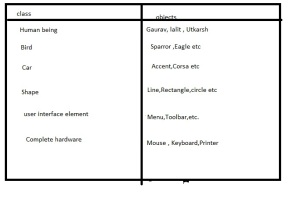 created from a single class. the class defines the type of objects that can be created according to the data the object can hold and operations the object can perform.
created from a single class. the class defines the type of objects that can be created according to the data the object can hold and operations the object can perform.
3 . Data Abstraction and Encapsulation :—
Abstraction refers to the act of representing essential features without including the background details or explanations..
classes use the concept of abstraction and are defined as a list of abstract attributes such as size , weight, and cost and functions to operate on these attributes.
The wrapping up of data functions into single unit is known as Encapsulation.
The data is not accessible to the outside world and only those function which are wrapped in the class can access it. these function provides the interface between the object’s data and
the program. The insulation of the data from
direct access by the program is called Data hiding or information hiding.
4 . Inheritance :– A process by which objects of one class acquire the properties of objects of another class.
supports the concepts of hierarchical classification.
In oops the concept of inheritance provides the idea of reusability. this means that we can add additional features to an existing class without modifying it. this is possible by deriving a new class from the existing one.
Subclass defines only those features which are unique to it. it includes its features explicitly.
5 . Polymorphism : — Polymorphism allows objects
having different internal structures
to share the same external interface.
Polymorphism is extensively used in implementing inheritance.
We can say the ability to assume several forms. the ability of entity to refer to objects of various classes at runtime.
C++ has three machanisms that help us to implement polymorphism
! .Function Overloading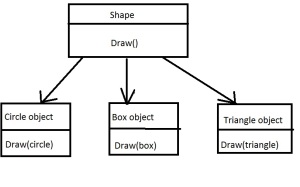
2. Operator Overloading
3.Virtual functions
6.Dynamic Binding :
Binding refers to the linking of a procedure call to the code to be executed in response to call. Dynamic binding means(late binding)
also means that the code associated with a given procedure is not known untill the time of the call at run time. it is associated with polymorphism and inheritance
you can understand this from above example by inheritance every object will have draw procedure but its definition is unique to each class so this procedure is redefined in each class that defines the object. the matching code is called at run time.
7. Message Passing :
in object oriented program consist of a set objects that communicate with each other.
they involves following steps.
1. create the class that defines objects and their behaviour
2. Create objects from that class
3. Establishing communication among objects.
What is difference between Object based language and object oriented language?
object oriented is not the right of any particular language . OOP concepts can be implemented using languages such as C and pascal. but it may generate confusion when program become larger.
A language is specially designed to support OOP concepts makes it easier to implement them
A language will have to support severals of OOPs concepts to claim it is Object oriented.
they can be classified in two ways:——–
1. Object based language
2. Object oriented language
features supported by Object based language :——–
1.Data encapsulation
2. Data hiding and access mechanisms
3. Automatic intialization and clear-up objects.
4. Operator overloading
They do not support Inheritance and Dynamic binding
Object oriented language it supports all object based programming features along with two additional features
1. Inheritance
2. Dynamic binding
. Object oriented language = Object based features + inheritance + dynamic binding
like – c++ and java
Applications of OOP :——-
Object oriented databases
Real time systems
Neural networks and parallel programming
CIM/CAD systems
https://csekapil.wordpress.com/2013/11/05/tree-learn-in-…for-interviews
https://csekapil.wordpress.com/2013/11/05/c-programms-as…ost-interviews/

